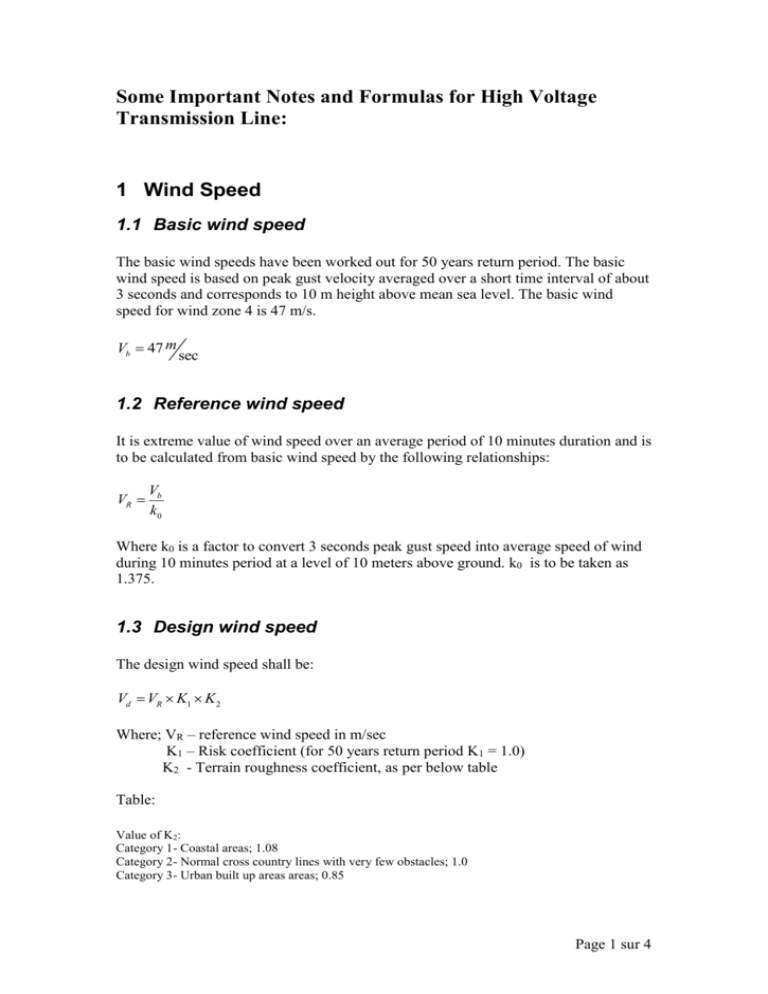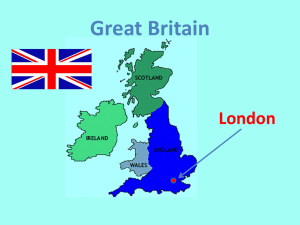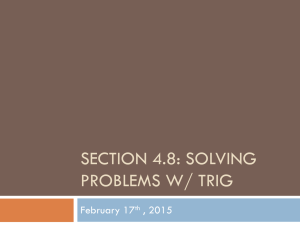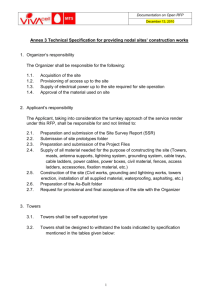1.2 Reference wind speed
advertisement

Some Important Notes and Formulas for High Voltage Transmission Line: 1 Wind Speed 1.1 Basic wind speed The basic wind speeds have been worked out for 50 years return period. The basic wind speed is based on peak gust velocity averaged over a short time interval of about 3 seconds and corresponds to 10 m height above mean sea level. The basic wind speed for wind zone 4 is 47 m/s. Vb 47 m sec 1.2 Reference wind speed It is extreme value of wind speed over an average period of 10 minutes duration and is to be calculated from basic wind speed by the following relationships: VR Vb k0 Where k0 is a factor to convert 3 seconds peak gust speed into average speed of wind during 10 minutes period at a level of 10 meters above ground. k0 is to be taken as 1.375. 1.3 Design wind speed The design wind speed shall be: Vd VR K1 K 2 Where; VR – reference wind speed in m/sec K1 – Risk coefficient (for 50 years return period K1 = 1.0) K2 - Terrain roughness coefficient, as per below table Table: Value of K2: Category 1- Coastal areas; 1.08 Category 2- Normal cross country lines with very few obstacles; 1.0 Category 3- Urban built up areas areas; 0.85 Page 1 sur 4 1.4 Design wind pressure The design wind pressure on towers, conductors and insulators shall be obtained by the following relationship: Pd 0.6 Vd2 where; Pd = Design wind pressure in N/m2 Vd = Design wind speed in m/sec 1.5 Design wind load on conductor & Groundwire Fwc Pd L D Gc Cdc , N Where; Pd L = = Design wind pressure in N/m2 wind span, being sum of half the span on either side of supporting point, in m D = Diameter of conductor/groundwire, in m Gc = Gust response factor depends on span, turbulence and height above the Ground; for 400 m span and terrain category 1 and 40 m heigh tower the Gc shall be 2.00. Cdc = Drag coefficient, which is 1.0 for conductor and 1.2 for groundwire. 1.6 Design wind load on Tower FWT Pd Cdt Ae GT , N Where; Pd = Design wind pressure in N/m2 Cdt = Drag coefficient, which depends on the solidity ratios, 2.0 to 3.6 Ae = total net surface area in m2 GT = Gust response factor Page 2 sur 4 1.7 Design wind load on Insulators FWi 1.2 Pd Ai Gi, N Where; Pd = Design wind pressure in N/m2 Ai = 0.5*dia of insulator*length of string in m2 2 Foundation 2.1 Concrete grade C20 : Characteristic strength of 20 N/mm2 This strength is the minimal design strength, which shall be confirmed from the cube test. 3 Tower 3.1 Base width The base width of the tower can be determined from the empirical formula: B k M ; cm Where; M K = Overturning moment, in kg-m = A constant; 1.93 In general the base width will be: (1/4 to 1/6 of overall height of the tower) ¼ is for heavy angle tower 1/5 is for medium angle tower 1/6 is for suspension tower Page 3 sur 4 3.2 Inclination of main legs Typical inclination of the tower legs (with vertical) for various voltages tower: Up to 220 kV: Suspension tower legs (in both directions): Angle towers (in both directions): Dead end Towers (in both directions): 40 70 80 400 kV and above: Suspension tower legs (in both directions): Angle towers (in both directions): Dead end Towers (in both directions): 80 100 110 3.3 Minimum Ground Clearance Voltage Level (kV) 66 132 220 400 Minimum ground Clearance (m) 5.5 6.1 7.0 8.8 4 Construction period 4.1 Tower erection 50 persons per month can erect 80 tonne 4.2 Stringing 50 persons per month will string 2 km double circuit transmission line. Page 4 sur 4











